A Comprehensive Report on Managing Food & Beverage Operations
VerifiedAdded on 2021/02/19
|13
|4175
|23
Report
AI Summary
This report, focusing on food and beverage (F&B) operations, begins with an introduction outlining the importance of F&B in the hospitality sector, using IBIS Hotels as a case study. It covers various business types, national and international rating systems (like hotel and Michelin stars), and current and future trends affecting F&B businesses, such as mobile room keys and fusion cooking. The report then analyzes customer motivation and behavior in selecting F&B outlets, considering factors like ambience, product quality, and brand reputation. It explores strategies used by outlets to attract customers, including special offers, free Wi-Fi, and loyalty programs, evaluating their effectiveness. Finally, it examines the influence of digital technology on consumer buying behavior and operational efficiency within the F&B industry.
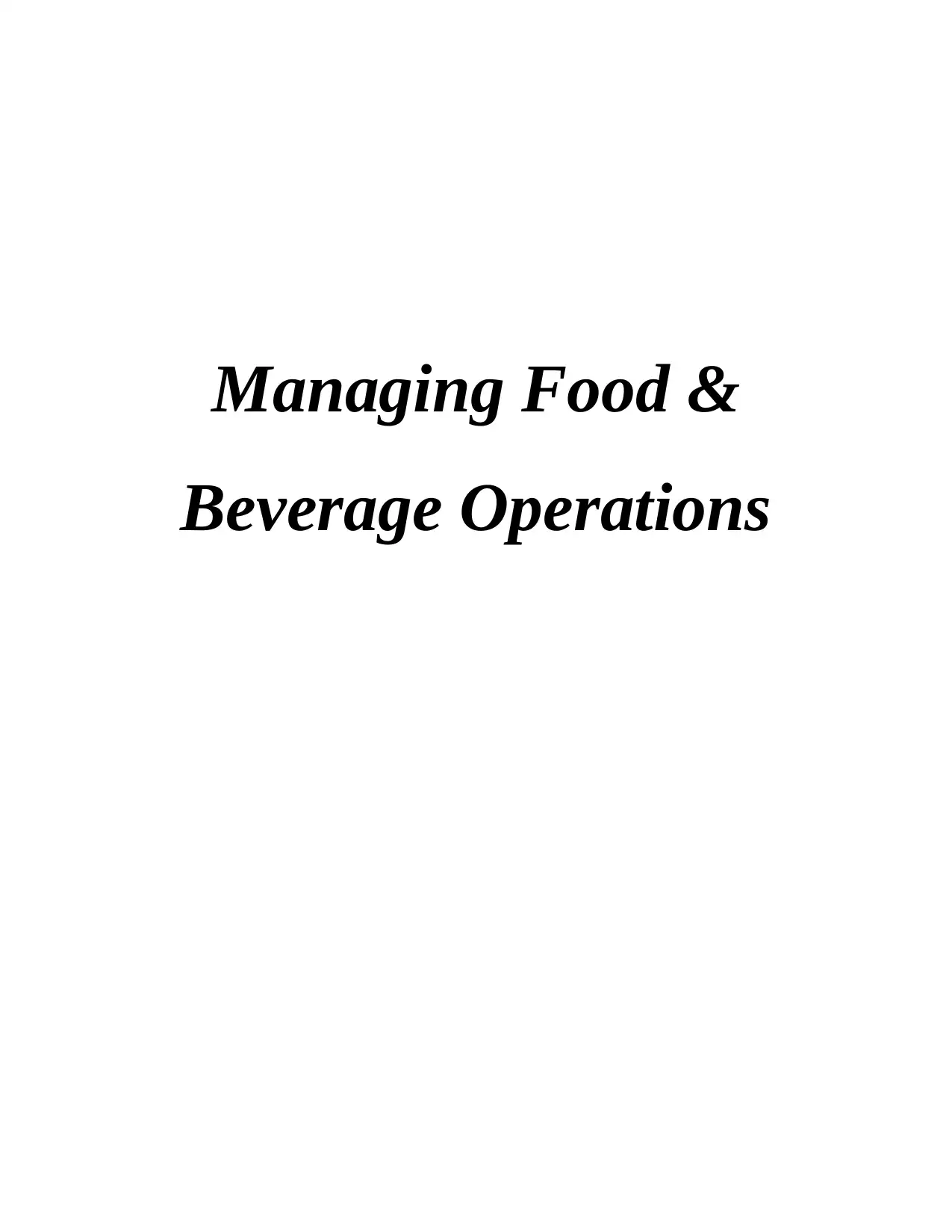
Managing Food &
Beverage Operations
Beverage Operations
Paraphrase This Document
Need a fresh take? Get an instant paraphrase of this document with our AI Paraphraser
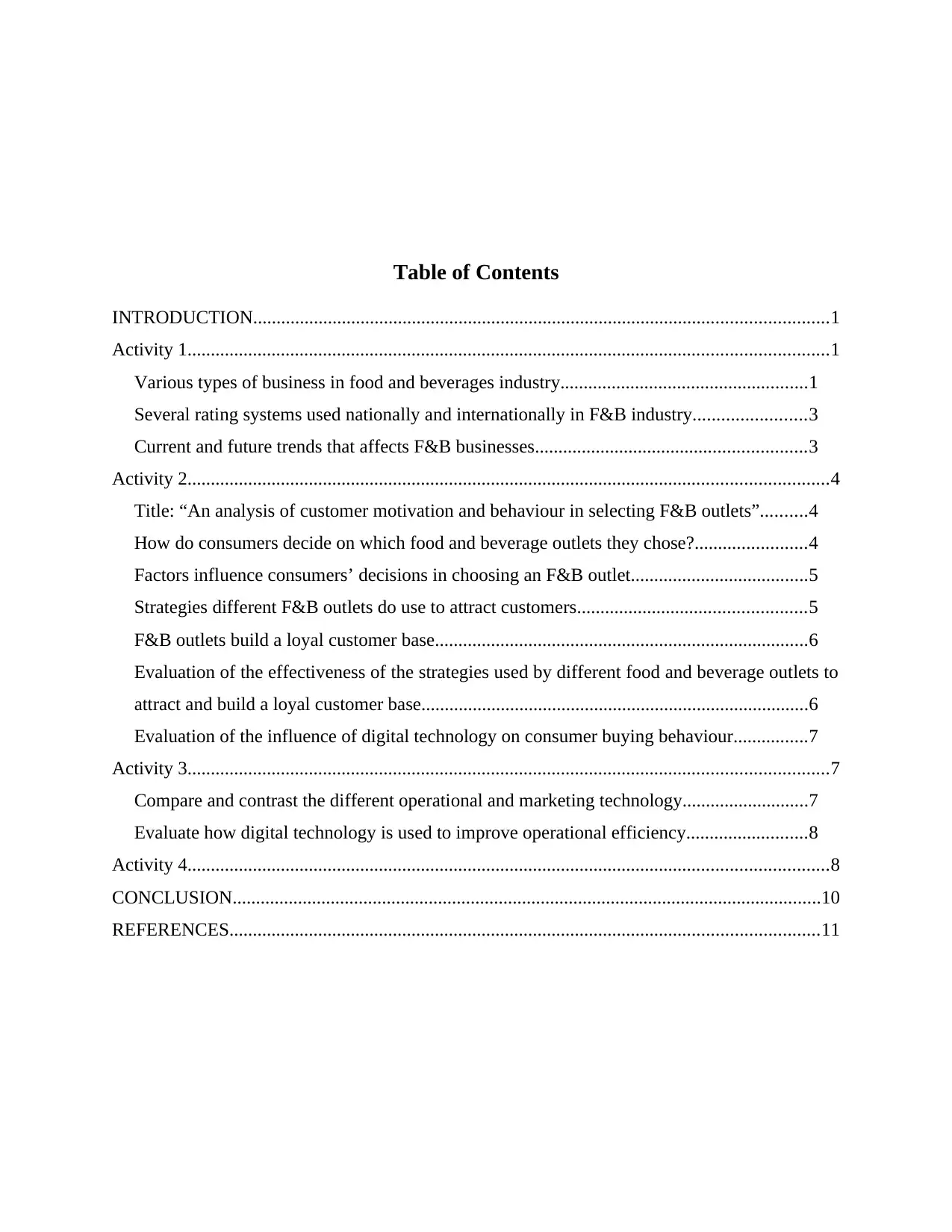
Table of Contents
INTRODUCTION...........................................................................................................................1
Activity 1.........................................................................................................................................1
Various types of business in food and beverages industry.....................................................1
Several rating systems used nationally and internationally in F&B industry........................3
Current and future trends that affects F&B businesses..........................................................3
Activity 2.........................................................................................................................................4
Title: “An analysis of customer motivation and behaviour in selecting F&B outlets”..........4
How do consumers decide on which food and beverage outlets they chose?........................4
Factors influence consumers’ decisions in choosing an F&B outlet......................................5
Strategies different F&B outlets do use to attract customers.................................................5
F&B outlets build a loyal customer base................................................................................6
Evaluation of the effectiveness of the strategies used by different food and beverage outlets to
attract and build a loyal customer base...................................................................................6
Evaluation of the influence of digital technology on consumer buying behaviour................7
Activity 3.........................................................................................................................................7
Compare and contrast the different operational and marketing technology...........................7
Evaluate how digital technology is used to improve operational efficiency..........................8
Activity 4.........................................................................................................................................8
CONCLUSION..............................................................................................................................10
REFERENCES..............................................................................................................................11
INTRODUCTION...........................................................................................................................1
Activity 1.........................................................................................................................................1
Various types of business in food and beverages industry.....................................................1
Several rating systems used nationally and internationally in F&B industry........................3
Current and future trends that affects F&B businesses..........................................................3
Activity 2.........................................................................................................................................4
Title: “An analysis of customer motivation and behaviour in selecting F&B outlets”..........4
How do consumers decide on which food and beverage outlets they chose?........................4
Factors influence consumers’ decisions in choosing an F&B outlet......................................5
Strategies different F&B outlets do use to attract customers.................................................5
F&B outlets build a loyal customer base................................................................................6
Evaluation of the effectiveness of the strategies used by different food and beverage outlets to
attract and build a loyal customer base...................................................................................6
Evaluation of the influence of digital technology on consumer buying behaviour................7
Activity 3.........................................................................................................................................7
Compare and contrast the different operational and marketing technology...........................7
Evaluate how digital technology is used to improve operational efficiency..........................8
Activity 4.........................................................................................................................................8
CONCLUSION..............................................................................................................................10
REFERENCES..............................................................................................................................11
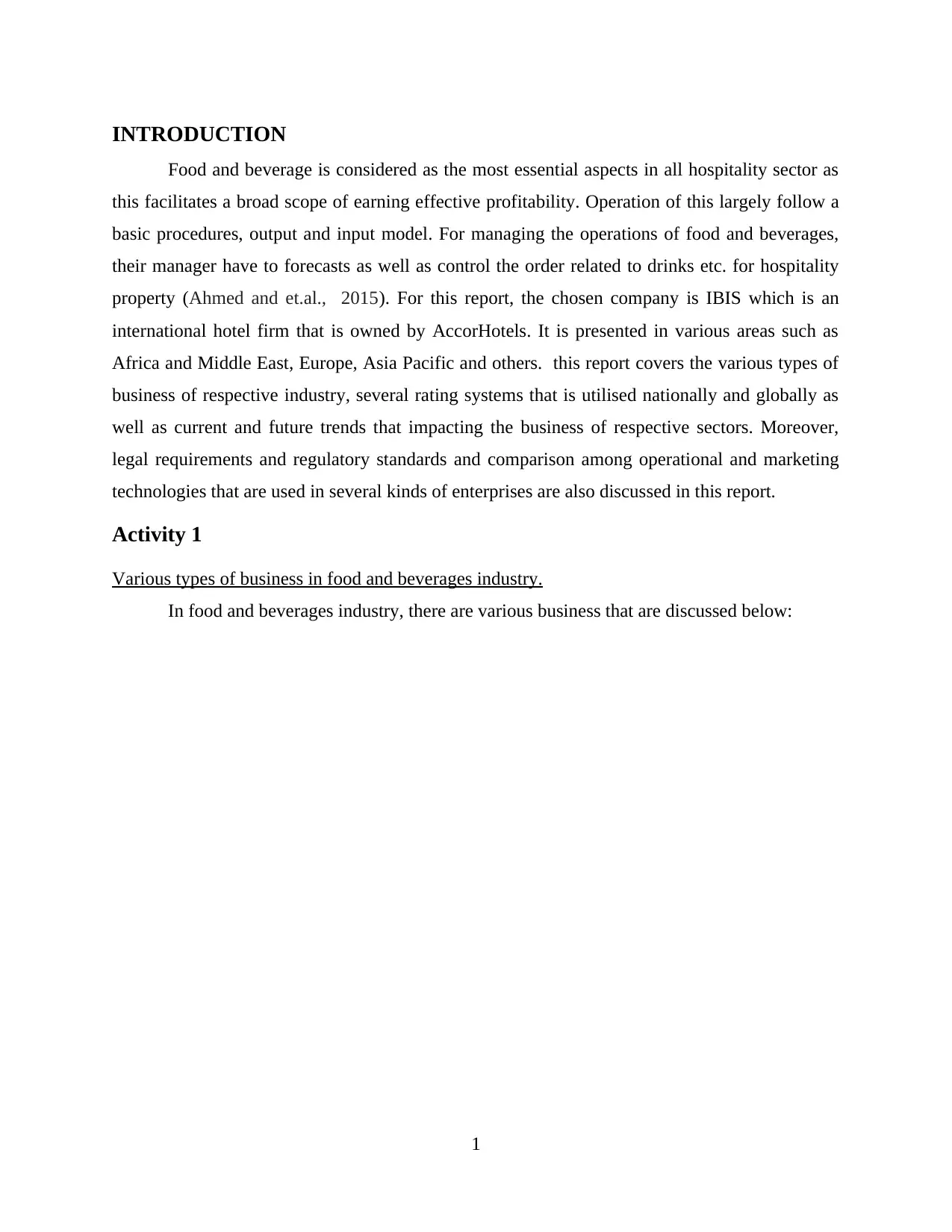
INTRODUCTION
Food and beverage is considered as the most essential aspects in all hospitality sector as
this facilitates a broad scope of earning effective profitability. Operation of this largely follow a
basic procedures, output and input model. For managing the operations of food and beverages,
their manager have to forecasts as well as control the order related to drinks etc. for hospitality
property (Ahmed and et.al., 2015). For this report, the chosen company is IBIS which is an
international hotel firm that is owned by AccorHotels. It is presented in various areas such as
Africa and Middle East, Europe, Asia Pacific and others. this report covers the various types of
business of respective industry, several rating systems that is utilised nationally and globally as
well as current and future trends that impacting the business of respective sectors. Moreover,
legal requirements and regulatory standards and comparison among operational and marketing
technologies that are used in several kinds of enterprises are also discussed in this report.
Activity 1
Various types of business in food and beverages industry.
In food and beverages industry, there are various business that are discussed below:
1
Food and beverage is considered as the most essential aspects in all hospitality sector as
this facilitates a broad scope of earning effective profitability. Operation of this largely follow a
basic procedures, output and input model. For managing the operations of food and beverages,
their manager have to forecasts as well as control the order related to drinks etc. for hospitality
property (Ahmed and et.al., 2015). For this report, the chosen company is IBIS which is an
international hotel firm that is owned by AccorHotels. It is presented in various areas such as
Africa and Middle East, Europe, Asia Pacific and others. this report covers the various types of
business of respective industry, several rating systems that is utilised nationally and globally as
well as current and future trends that impacting the business of respective sectors. Moreover,
legal requirements and regulatory standards and comparison among operational and marketing
technologies that are used in several kinds of enterprises are also discussed in this report.
Activity 1
Various types of business in food and beverages industry.
In food and beverages industry, there are various business that are discussed below:
1
⊘ This is a preview!⊘
Do you want full access?
Subscribe today to unlock all pages.

Trusted by 1+ million students worldwide
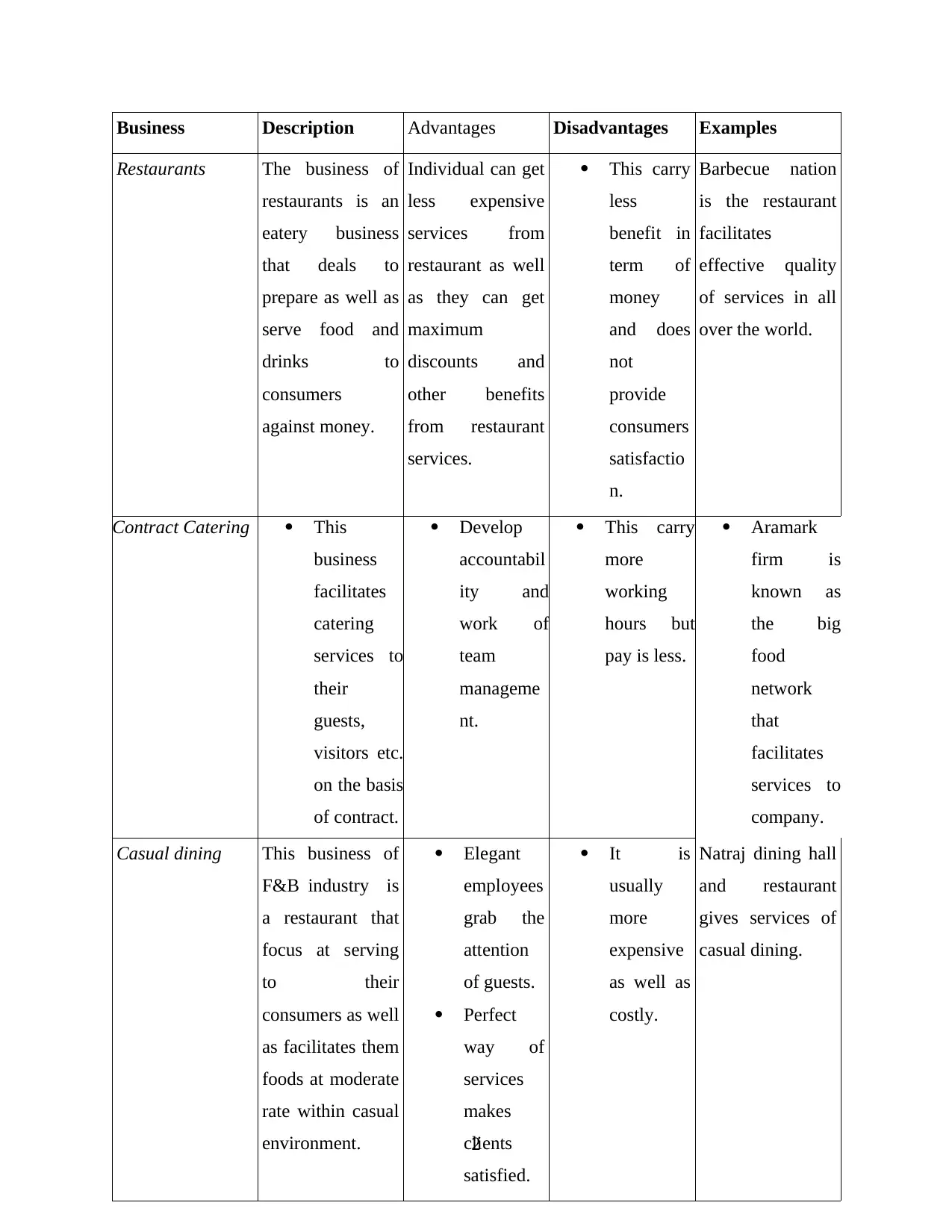
2
Business Description Advantages Disadvantages Examples
Restaurants The business of
restaurants is an
eatery business
that deals to
prepare as well as
serve food and
drinks to
consumers
against money.
Individual can get
less expensive
services from
restaurant as well
as they can get
maximum
discounts and
other benefits
from restaurant
services.
This carry
less
benefit in
term of
money
and does
not
provide
consumers
satisfactio
n.
Barbecue nation
is the restaurant
facilitates
effective quality
of services in all
over the world.
Contract Catering This
business
facilitates
catering
services to
their
guests,
visitors etc.
on the basis
of contract.
Develop
accountabil
ity and
work of
team
manageme
nt.
This carry
more
working
hours but
pay is less.
Aramark
firm is
known as
the big
food
network
that
facilitates
services to
company.
Casual dining This business of
F&B industry is
a restaurant that
focus at serving
to their
consumers as well
as facilitates them
foods at moderate
rate within casual
environment.
Elegant
employees
grab the
attention
of guests.
Perfect
way of
services
makes
clients
satisfied.
It is
usually
more
expensive
as well as
costly.
Natraj dining hall
and restaurant
gives services of
casual dining.
Business Description Advantages Disadvantages Examples
Restaurants The business of
restaurants is an
eatery business
that deals to
prepare as well as
serve food and
drinks to
consumers
against money.
Individual can get
less expensive
services from
restaurant as well
as they can get
maximum
discounts and
other benefits
from restaurant
services.
This carry
less
benefit in
term of
money
and does
not
provide
consumers
satisfactio
n.
Barbecue nation
is the restaurant
facilitates
effective quality
of services in all
over the world.
Contract Catering This
business
facilitates
catering
services to
their
guests,
visitors etc.
on the basis
of contract.
Develop
accountabil
ity and
work of
team
manageme
nt.
This carry
more
working
hours but
pay is less.
Aramark
firm is
known as
the big
food
network
that
facilitates
services to
company.
Casual dining This business of
F&B industry is
a restaurant that
focus at serving
to their
consumers as well
as facilitates them
foods at moderate
rate within casual
environment.
Elegant
employees
grab the
attention
of guests.
Perfect
way of
services
makes
clients
satisfied.
It is
usually
more
expensive
as well as
costly.
Natraj dining hall
and restaurant
gives services of
casual dining.
Paraphrase This Document
Need a fresh take? Get an instant paraphrase of this document with our AI Paraphraser
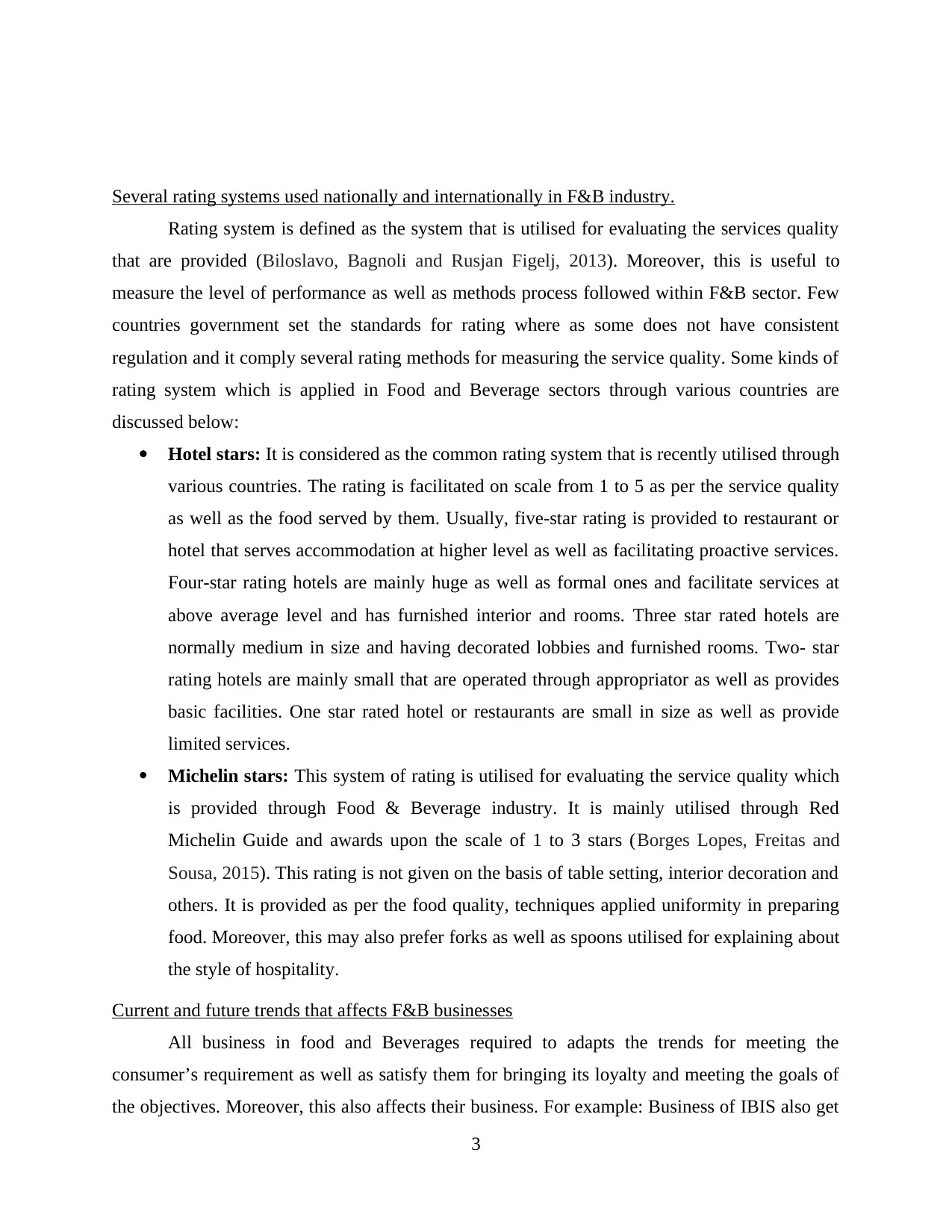
Several rating systems used nationally and internationally in F&B industry.
Rating system is defined as the system that is utilised for evaluating the services quality
that are provided (Biloslavo, Bagnoli and Rusjan Figelj, 2013). Moreover, this is useful to
measure the level of performance as well as methods process followed within F&B sector. Few
countries government set the standards for rating where as some does not have consistent
regulation and it comply several rating methods for measuring the service quality. Some kinds of
rating system which is applied in Food and Beverage sectors through various countries are
discussed below:
Hotel stars: It is considered as the common rating system that is recently utilised through
various countries. The rating is facilitated on scale from 1 to 5 as per the service quality
as well as the food served by them. Usually, five-star rating is provided to restaurant or
hotel that serves accommodation at higher level as well as facilitating proactive services.
Four-star rating hotels are mainly huge as well as formal ones and facilitate services at
above average level and has furnished interior and rooms. Three star rated hotels are
normally medium in size and having decorated lobbies and furnished rooms. Two- star
rating hotels are mainly small that are operated through appropriator as well as provides
basic facilities. One star rated hotel or restaurants are small in size as well as provide
limited services.
Michelin stars: This system of rating is utilised for evaluating the service quality which
is provided through Food & Beverage industry. It is mainly utilised through Red
Michelin Guide and awards upon the scale of 1 to 3 stars (Borges Lopes, Freitas and
Sousa, 2015). This rating is not given on the basis of table setting, interior decoration and
others. It is provided as per the food quality, techniques applied uniformity in preparing
food. Moreover, this may also prefer forks as well as spoons utilised for explaining about
the style of hospitality.
Current and future trends that affects F&B businesses
All business in food and Beverages required to adapts the trends for meeting the
consumer’s requirement as well as satisfy them for bringing its loyalty and meeting the goals of
the objectives. Moreover, this also affects their business. For example: Business of IBIS also get
3
Rating system is defined as the system that is utilised for evaluating the services quality
that are provided (Biloslavo, Bagnoli and Rusjan Figelj, 2013). Moreover, this is useful to
measure the level of performance as well as methods process followed within F&B sector. Few
countries government set the standards for rating where as some does not have consistent
regulation and it comply several rating methods for measuring the service quality. Some kinds of
rating system which is applied in Food and Beverage sectors through various countries are
discussed below:
Hotel stars: It is considered as the common rating system that is recently utilised through
various countries. The rating is facilitated on scale from 1 to 5 as per the service quality
as well as the food served by them. Usually, five-star rating is provided to restaurant or
hotel that serves accommodation at higher level as well as facilitating proactive services.
Four-star rating hotels are mainly huge as well as formal ones and facilitate services at
above average level and has furnished interior and rooms. Three star rated hotels are
normally medium in size and having decorated lobbies and furnished rooms. Two- star
rating hotels are mainly small that are operated through appropriator as well as provides
basic facilities. One star rated hotel or restaurants are small in size as well as provide
limited services.
Michelin stars: This system of rating is utilised for evaluating the service quality which
is provided through Food & Beverage industry. It is mainly utilised through Red
Michelin Guide and awards upon the scale of 1 to 3 stars (Borges Lopes, Freitas and
Sousa, 2015). This rating is not given on the basis of table setting, interior decoration and
others. It is provided as per the food quality, techniques applied uniformity in preparing
food. Moreover, this may also prefer forks as well as spoons utilised for explaining about
the style of hospitality.
Current and future trends that affects F&B businesses
All business in food and Beverages required to adapts the trends for meeting the
consumer’s requirement as well as satisfy them for bringing its loyalty and meeting the goals of
the objectives. Moreover, this also affects their business. For example: Business of IBIS also get
3
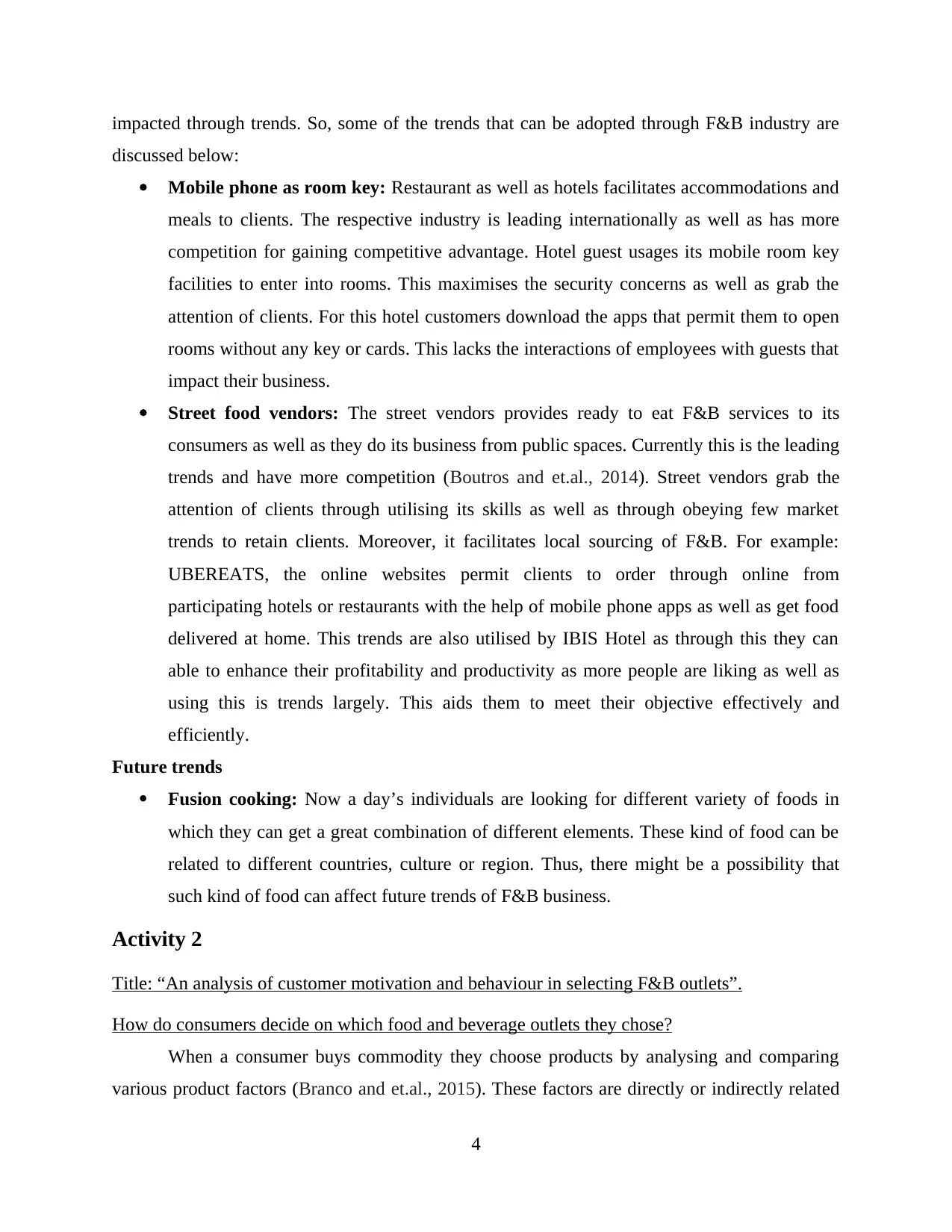
impacted through trends. So, some of the trends that can be adopted through F&B industry are
discussed below:
Mobile phone as room key: Restaurant as well as hotels facilitates accommodations and
meals to clients. The respective industry is leading internationally as well as has more
competition for gaining competitive advantage. Hotel guest usages its mobile room key
facilities to enter into rooms. This maximises the security concerns as well as grab the
attention of clients. For this hotel customers download the apps that permit them to open
rooms without any key or cards. This lacks the interactions of employees with guests that
impact their business.
Street food vendors: The street vendors provides ready to eat F&B services to its
consumers as well as they do its business from public spaces. Currently this is the leading
trends and have more competition (Boutros and et.al., 2014). Street vendors grab the
attention of clients through utilising its skills as well as through obeying few market
trends to retain clients. Moreover, it facilitates local sourcing of F&B. For example:
UBEREATS, the online websites permit clients to order through online from
participating hotels or restaurants with the help of mobile phone apps as well as get food
delivered at home. This trends are also utilised by IBIS Hotel as through this they can
able to enhance their profitability and productivity as more people are liking as well as
using this is trends largely. This aids them to meet their objective effectively and
efficiently.
Future trends
Fusion cooking: Now a day’s individuals are looking for different variety of foods in
which they can get a great combination of different elements. These kind of food can be
related to different countries, culture or region. Thus, there might be a possibility that
such kind of food can affect future trends of F&B business.
Activity 2
Title: “An analysis of customer motivation and behaviour in selecting F&B outlets”.
How do consumers decide on which food and beverage outlets they chose?
When a consumer buys commodity they choose products by analysing and comparing
various product factors (Branco and et.al., 2015). These factors are directly or indirectly related
4
discussed below:
Mobile phone as room key: Restaurant as well as hotels facilitates accommodations and
meals to clients. The respective industry is leading internationally as well as has more
competition for gaining competitive advantage. Hotel guest usages its mobile room key
facilities to enter into rooms. This maximises the security concerns as well as grab the
attention of clients. For this hotel customers download the apps that permit them to open
rooms without any key or cards. This lacks the interactions of employees with guests that
impact their business.
Street food vendors: The street vendors provides ready to eat F&B services to its
consumers as well as they do its business from public spaces. Currently this is the leading
trends and have more competition (Boutros and et.al., 2014). Street vendors grab the
attention of clients through utilising its skills as well as through obeying few market
trends to retain clients. Moreover, it facilitates local sourcing of F&B. For example:
UBEREATS, the online websites permit clients to order through online from
participating hotels or restaurants with the help of mobile phone apps as well as get food
delivered at home. This trends are also utilised by IBIS Hotel as through this they can
able to enhance their profitability and productivity as more people are liking as well as
using this is trends largely. This aids them to meet their objective effectively and
efficiently.
Future trends
Fusion cooking: Now a day’s individuals are looking for different variety of foods in
which they can get a great combination of different elements. These kind of food can be
related to different countries, culture or region. Thus, there might be a possibility that
such kind of food can affect future trends of F&B business.
Activity 2
Title: “An analysis of customer motivation and behaviour in selecting F&B outlets”.
How do consumers decide on which food and beverage outlets they chose?
When a consumer buys commodity they choose products by analysing and comparing
various product factors (Branco and et.al., 2015). These factors are directly or indirectly related
4
⊘ This is a preview!⊘
Do you want full access?
Subscribe today to unlock all pages.

Trusted by 1+ million students worldwide
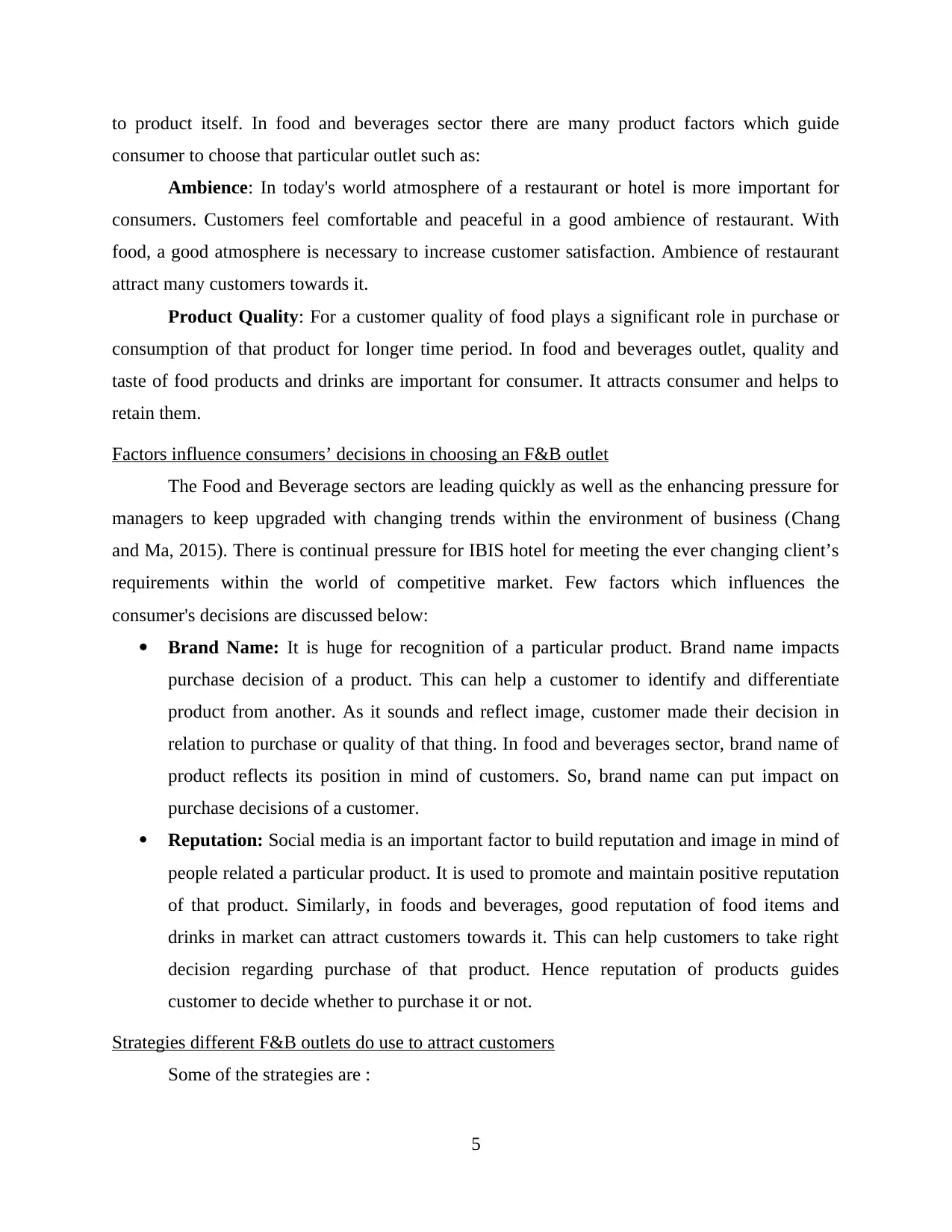
to product itself. In food and beverages sector there are many product factors which guide
consumer to choose that particular outlet such as:
Ambience: In today's world atmosphere of a restaurant or hotel is more important for
consumers. Customers feel comfortable and peaceful in a good ambience of restaurant. With
food, a good atmosphere is necessary to increase customer satisfaction. Ambience of restaurant
attract many customers towards it.
Product Quality: For a customer quality of food plays a significant role in purchase or
consumption of that product for longer time period. In food and beverages outlet, quality and
taste of food products and drinks are important for consumer. It attracts consumer and helps to
retain them.
Factors influence consumers’ decisions in choosing an F&B outlet
The Food and Beverage sectors are leading quickly as well as the enhancing pressure for
managers to keep upgraded with changing trends within the environment of business (Chang
and Ma, 2015). There is continual pressure for IBIS hotel for meeting the ever changing client’s
requirements within the world of competitive market. Few factors which influences the
consumer's decisions are discussed below:
Brand Name: It is huge for recognition of a particular product. Brand name impacts
purchase decision of a product. This can help a customer to identify and differentiate
product from another. As it sounds and reflect image, customer made their decision in
relation to purchase or quality of that thing. In food and beverages sector, brand name of
product reflects its position in mind of customers. So, brand name can put impact on
purchase decisions of a customer.
Reputation: Social media is an important factor to build reputation and image in mind of
people related a particular product. It is used to promote and maintain positive reputation
of that product. Similarly, in foods and beverages, good reputation of food items and
drinks in market can attract customers towards it. This can help customers to take right
decision regarding purchase of that product. Hence reputation of products guides
customer to decide whether to purchase it or not.
Strategies different F&B outlets do use to attract customers
Some of the strategies are :
5
consumer to choose that particular outlet such as:
Ambience: In today's world atmosphere of a restaurant or hotel is more important for
consumers. Customers feel comfortable and peaceful in a good ambience of restaurant. With
food, a good atmosphere is necessary to increase customer satisfaction. Ambience of restaurant
attract many customers towards it.
Product Quality: For a customer quality of food plays a significant role in purchase or
consumption of that product for longer time period. In food and beverages outlet, quality and
taste of food products and drinks are important for consumer. It attracts consumer and helps to
retain them.
Factors influence consumers’ decisions in choosing an F&B outlet
The Food and Beverage sectors are leading quickly as well as the enhancing pressure for
managers to keep upgraded with changing trends within the environment of business (Chang
and Ma, 2015). There is continual pressure for IBIS hotel for meeting the ever changing client’s
requirements within the world of competitive market. Few factors which influences the
consumer's decisions are discussed below:
Brand Name: It is huge for recognition of a particular product. Brand name impacts
purchase decision of a product. This can help a customer to identify and differentiate
product from another. As it sounds and reflect image, customer made their decision in
relation to purchase or quality of that thing. In food and beverages sector, brand name of
product reflects its position in mind of customers. So, brand name can put impact on
purchase decisions of a customer.
Reputation: Social media is an important factor to build reputation and image in mind of
people related a particular product. It is used to promote and maintain positive reputation
of that product. Similarly, in foods and beverages, good reputation of food items and
drinks in market can attract customers towards it. This can help customers to take right
decision regarding purchase of that product. Hence reputation of products guides
customer to decide whether to purchase it or not.
Strategies different F&B outlets do use to attract customers
Some of the strategies are :
5
Paraphrase This Document
Need a fresh take? Get an instant paraphrase of this document with our AI Paraphraser
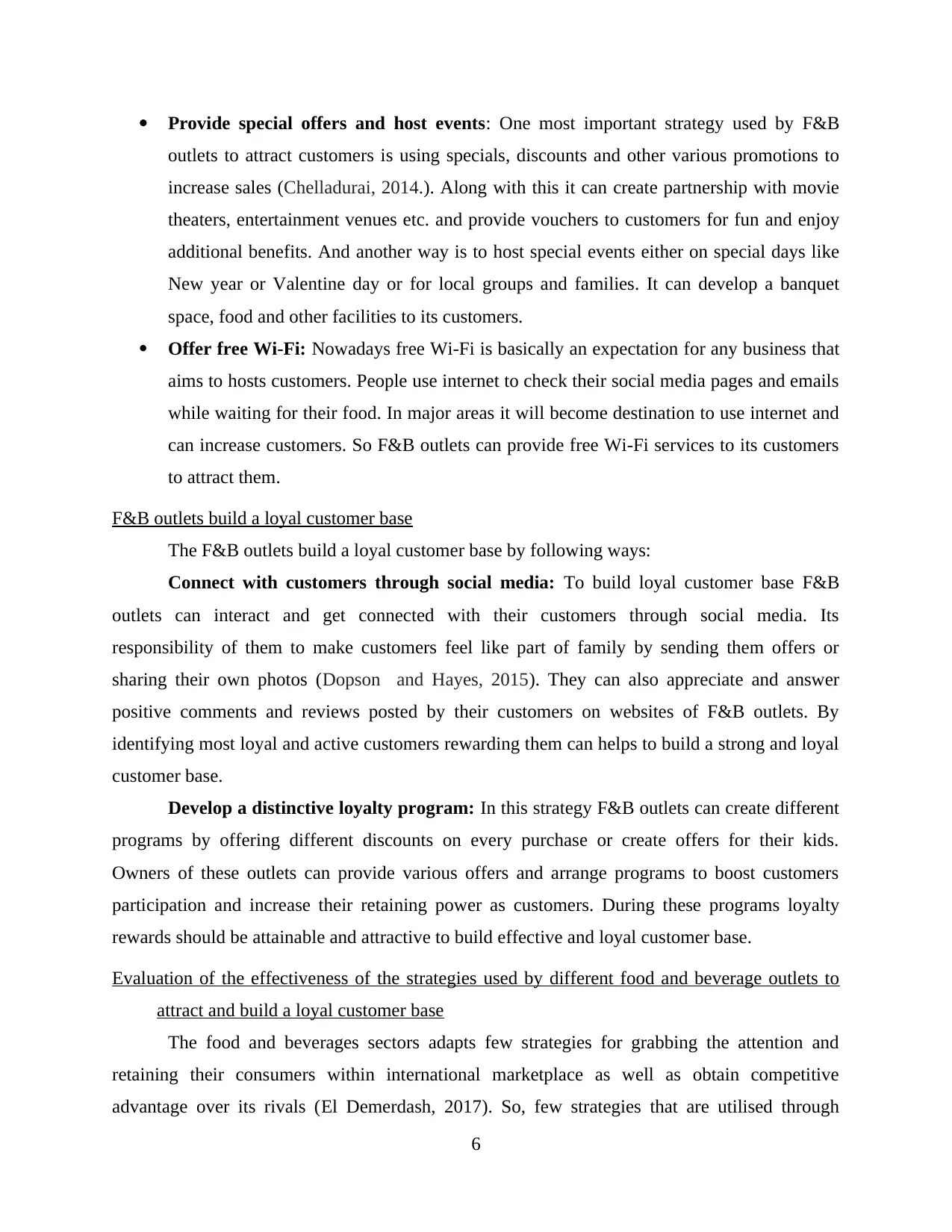
Provide special offers and host events: One most important strategy used by F&B
outlets to attract customers is using specials, discounts and other various promotions to
increase sales (Chelladurai, 2014.). Along with this it can create partnership with movie
theaters, entertainment venues etc. and provide vouchers to customers for fun and enjoy
additional benefits. And another way is to host special events either on special days like
New year or Valentine day or for local groups and families. It can develop a banquet
space, food and other facilities to its customers.
Offer free Wi-Fi: Nowadays free Wi-Fi is basically an expectation for any business that
aims to hosts customers. People use internet to check their social media pages and emails
while waiting for their food. In major areas it will become destination to use internet and
can increase customers. So F&B outlets can provide free Wi-Fi services to its customers
to attract them.
F&B outlets build a loyal customer base
The F&B outlets build a loyal customer base by following ways:
Connect with customers through social media: To build loyal customer base F&B
outlets can interact and get connected with their customers through social media. Its
responsibility of them to make customers feel like part of family by sending them offers or
sharing their own photos (Dopson and Hayes, 2015). They can also appreciate and answer
positive comments and reviews posted by their customers on websites of F&B outlets. By
identifying most loyal and active customers rewarding them can helps to build a strong and loyal
customer base.
Develop a distinctive loyalty program: In this strategy F&B outlets can create different
programs by offering different discounts on every purchase or create offers for their kids.
Owners of these outlets can provide various offers and arrange programs to boost customers
participation and increase their retaining power as customers. During these programs loyalty
rewards should be attainable and attractive to build effective and loyal customer base.
Evaluation of the effectiveness of the strategies used by different food and beverage outlets to
attract and build a loyal customer base
The food and beverages sectors adapts few strategies for grabbing the attention and
retaining their consumers within international marketplace as well as obtain competitive
advantage over its rivals (El Demerdash, 2017). So, few strategies that are utilised through
6
outlets to attract customers is using specials, discounts and other various promotions to
increase sales (Chelladurai, 2014.). Along with this it can create partnership with movie
theaters, entertainment venues etc. and provide vouchers to customers for fun and enjoy
additional benefits. And another way is to host special events either on special days like
New year or Valentine day or for local groups and families. It can develop a banquet
space, food and other facilities to its customers.
Offer free Wi-Fi: Nowadays free Wi-Fi is basically an expectation for any business that
aims to hosts customers. People use internet to check their social media pages and emails
while waiting for their food. In major areas it will become destination to use internet and
can increase customers. So F&B outlets can provide free Wi-Fi services to its customers
to attract them.
F&B outlets build a loyal customer base
The F&B outlets build a loyal customer base by following ways:
Connect with customers through social media: To build loyal customer base F&B
outlets can interact and get connected with their customers through social media. Its
responsibility of them to make customers feel like part of family by sending them offers or
sharing their own photos (Dopson and Hayes, 2015). They can also appreciate and answer
positive comments and reviews posted by their customers on websites of F&B outlets. By
identifying most loyal and active customers rewarding them can helps to build a strong and loyal
customer base.
Develop a distinctive loyalty program: In this strategy F&B outlets can create different
programs by offering different discounts on every purchase or create offers for their kids.
Owners of these outlets can provide various offers and arrange programs to boost customers
participation and increase their retaining power as customers. During these programs loyalty
rewards should be attainable and attractive to build effective and loyal customer base.
Evaluation of the effectiveness of the strategies used by different food and beverage outlets to
attract and build a loyal customer base
The food and beverages sectors adapts few strategies for grabbing the attention and
retaining their consumers within international marketplace as well as obtain competitive
advantage over its rivals (El Demerdash, 2017). So, few strategies that are utilised through
6
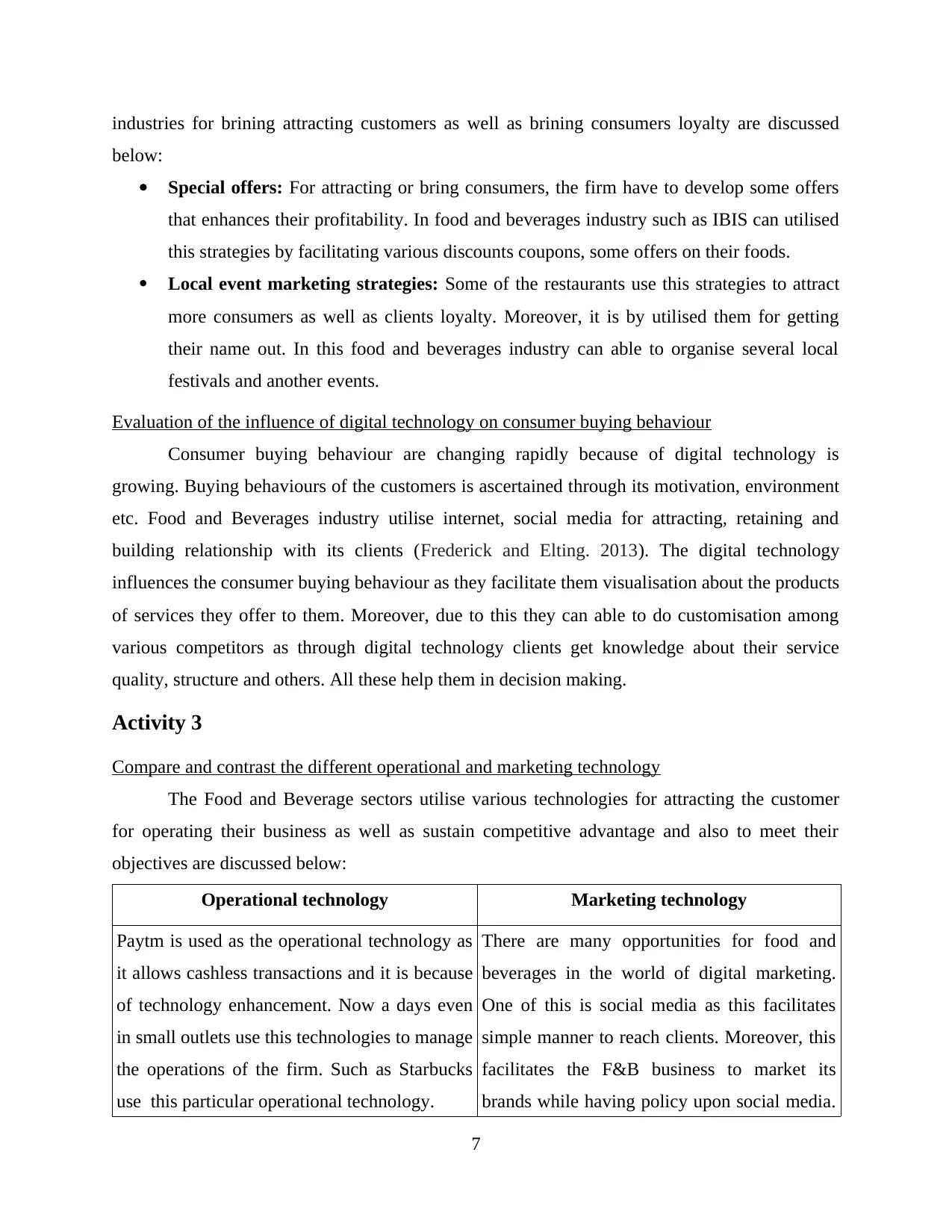
industries for brining attracting customers as well as brining consumers loyalty are discussed
below:
Special offers: For attracting or bring consumers, the firm have to develop some offers
that enhances their profitability. In food and beverages industry such as IBIS can utilised
this strategies by facilitating various discounts coupons, some offers on their foods.
Local event marketing strategies: Some of the restaurants use this strategies to attract
more consumers as well as clients loyalty. Moreover, it is by utilised them for getting
their name out. In this food and beverages industry can able to organise several local
festivals and another events.
Evaluation of the influence of digital technology on consumer buying behaviour
Consumer buying behaviour are changing rapidly because of digital technology is
growing. Buying behaviours of the customers is ascertained through its motivation, environment
etc. Food and Beverages industry utilise internet, social media for attracting, retaining and
building relationship with its clients (Frederick and Elting. 2013). The digital technology
influences the consumer buying behaviour as they facilitate them visualisation about the products
of services they offer to them. Moreover, due to this they can able to do customisation among
various competitors as through digital technology clients get knowledge about their service
quality, structure and others. All these help them in decision making.
Activity 3
Compare and contrast the different operational and marketing technology
The Food and Beverage sectors utilise various technologies for attracting the customer
for operating their business as well as sustain competitive advantage and also to meet their
objectives are discussed below:
Operational technology Marketing technology
Paytm is used as the operational technology as
it allows cashless transactions and it is because
of technology enhancement. Now a days even
in small outlets use this technologies to manage
the operations of the firm. Such as Starbucks
use this particular operational technology.
There are many opportunities for food and
beverages in the world of digital marketing.
One of this is social media as this facilitates
simple manner to reach clients. Moreover, this
facilitates the F&B business to market its
brands while having policy upon social media.
7
below:
Special offers: For attracting or bring consumers, the firm have to develop some offers
that enhances their profitability. In food and beverages industry such as IBIS can utilised
this strategies by facilitating various discounts coupons, some offers on their foods.
Local event marketing strategies: Some of the restaurants use this strategies to attract
more consumers as well as clients loyalty. Moreover, it is by utilised them for getting
their name out. In this food and beverages industry can able to organise several local
festivals and another events.
Evaluation of the influence of digital technology on consumer buying behaviour
Consumer buying behaviour are changing rapidly because of digital technology is
growing. Buying behaviours of the customers is ascertained through its motivation, environment
etc. Food and Beverages industry utilise internet, social media for attracting, retaining and
building relationship with its clients (Frederick and Elting. 2013). The digital technology
influences the consumer buying behaviour as they facilitate them visualisation about the products
of services they offer to them. Moreover, due to this they can able to do customisation among
various competitors as through digital technology clients get knowledge about their service
quality, structure and others. All these help them in decision making.
Activity 3
Compare and contrast the different operational and marketing technology
The Food and Beverage sectors utilise various technologies for attracting the customer
for operating their business as well as sustain competitive advantage and also to meet their
objectives are discussed below:
Operational technology Marketing technology
Paytm is used as the operational technology as
it allows cashless transactions and it is because
of technology enhancement. Now a days even
in small outlets use this technologies to manage
the operations of the firm. Such as Starbucks
use this particular operational technology.
There are many opportunities for food and
beverages in the world of digital marketing.
One of this is social media as this facilitates
simple manner to reach clients. Moreover, this
facilitates the F&B business to market its
brands while having policy upon social media.
7
⊘ This is a preview!⊘
Do you want full access?
Subscribe today to unlock all pages.

Trusted by 1+ million students worldwide
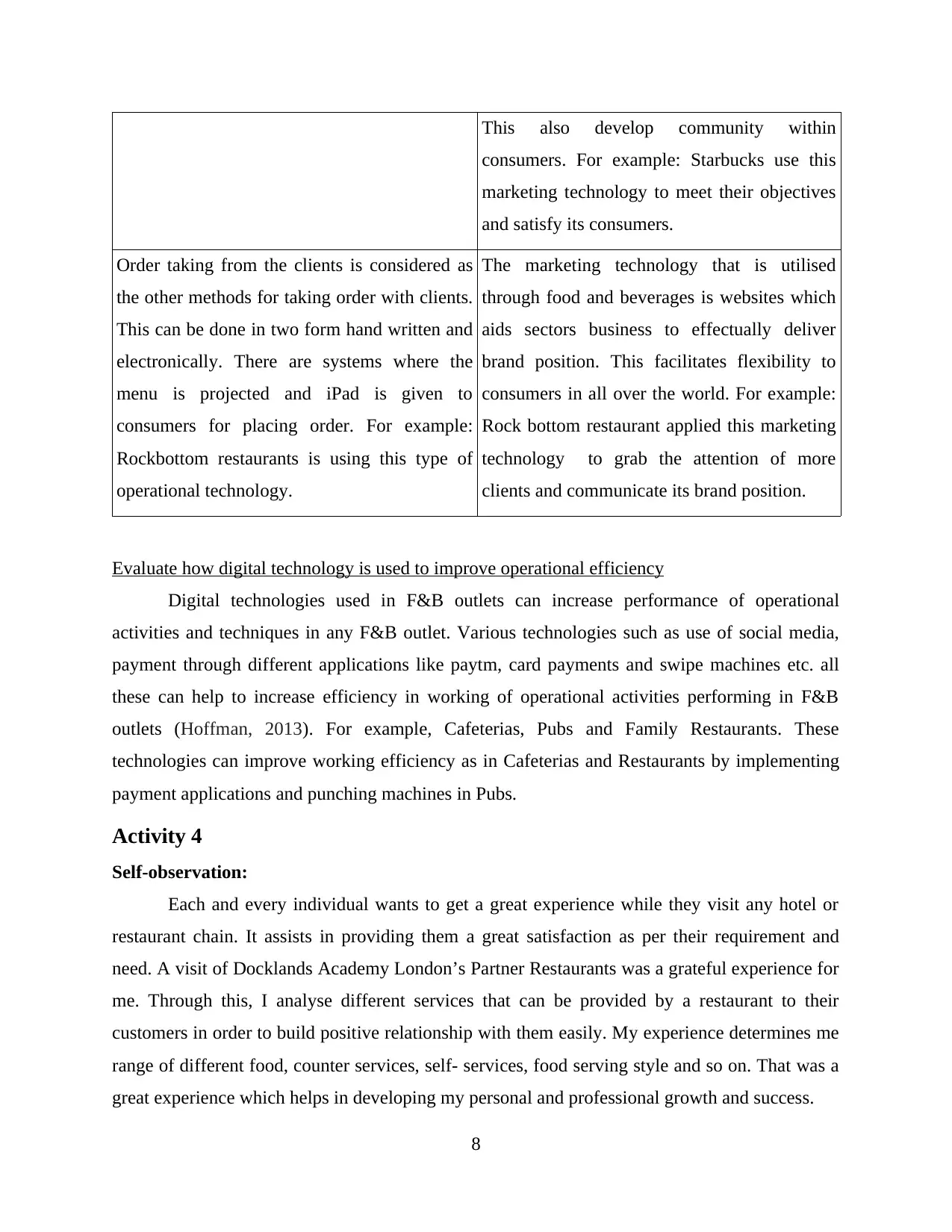
This also develop community within
consumers. For example: Starbucks use this
marketing technology to meet their objectives
and satisfy its consumers.
Order taking from the clients is considered as
the other methods for taking order with clients.
This can be done in two form hand written and
electronically. There are systems where the
menu is projected and iPad is given to
consumers for placing order. For example:
Rockbottom restaurants is using this type of
operational technology.
The marketing technology that is utilised
through food and beverages is websites which
aids sectors business to effectually deliver
brand position. This facilitates flexibility to
consumers in all over the world. For example:
Rock bottom restaurant applied this marketing
technology to grab the attention of more
clients and communicate its brand position.
Evaluate how digital technology is used to improve operational efficiency
Digital technologies used in F&B outlets can increase performance of operational
activities and techniques in any F&B outlet. Various technologies such as use of social media,
payment through different applications like paytm, card payments and swipe machines etc. all
these can help to increase efficiency in working of operational activities performing in F&B
outlets (Hoffman, 2013). For example, Cafeterias, Pubs and Family Restaurants. These
technologies can improve working efficiency as in Cafeterias and Restaurants by implementing
payment applications and punching machines in Pubs.
Activity 4
Self-observation:
Each and every individual wants to get a great experience while they visit any hotel or
restaurant chain. It assists in providing them a great satisfaction as per their requirement and
need. A visit of Docklands Academy London’s Partner Restaurants was a grateful experience for
me. Through this, I analyse different services that can be provided by a restaurant to their
customers in order to build positive relationship with them easily. My experience determines me
range of different food, counter services, self- services, food serving style and so on. That was a
great experience which helps in developing my personal and professional growth and success.
8
consumers. For example: Starbucks use this
marketing technology to meet their objectives
and satisfy its consumers.
Order taking from the clients is considered as
the other methods for taking order with clients.
This can be done in two form hand written and
electronically. There are systems where the
menu is projected and iPad is given to
consumers for placing order. For example:
Rockbottom restaurants is using this type of
operational technology.
The marketing technology that is utilised
through food and beverages is websites which
aids sectors business to effectually deliver
brand position. This facilitates flexibility to
consumers in all over the world. For example:
Rock bottom restaurant applied this marketing
technology to grab the attention of more
clients and communicate its brand position.
Evaluate how digital technology is used to improve operational efficiency
Digital technologies used in F&B outlets can increase performance of operational
activities and techniques in any F&B outlet. Various technologies such as use of social media,
payment through different applications like paytm, card payments and swipe machines etc. all
these can help to increase efficiency in working of operational activities performing in F&B
outlets (Hoffman, 2013). For example, Cafeterias, Pubs and Family Restaurants. These
technologies can improve working efficiency as in Cafeterias and Restaurants by implementing
payment applications and punching machines in Pubs.
Activity 4
Self-observation:
Each and every individual wants to get a great experience while they visit any hotel or
restaurant chain. It assists in providing them a great satisfaction as per their requirement and
need. A visit of Docklands Academy London’s Partner Restaurants was a grateful experience for
me. Through this, I analyse different services that can be provided by a restaurant to their
customers in order to build positive relationship with them easily. My experience determines me
range of different food, counter services, self- services, food serving style and so on. That was a
great experience which helps in developing my personal and professional growth and success.
8
Paraphrase This Document
Need a fresh take? Get an instant paraphrase of this document with our AI Paraphraser
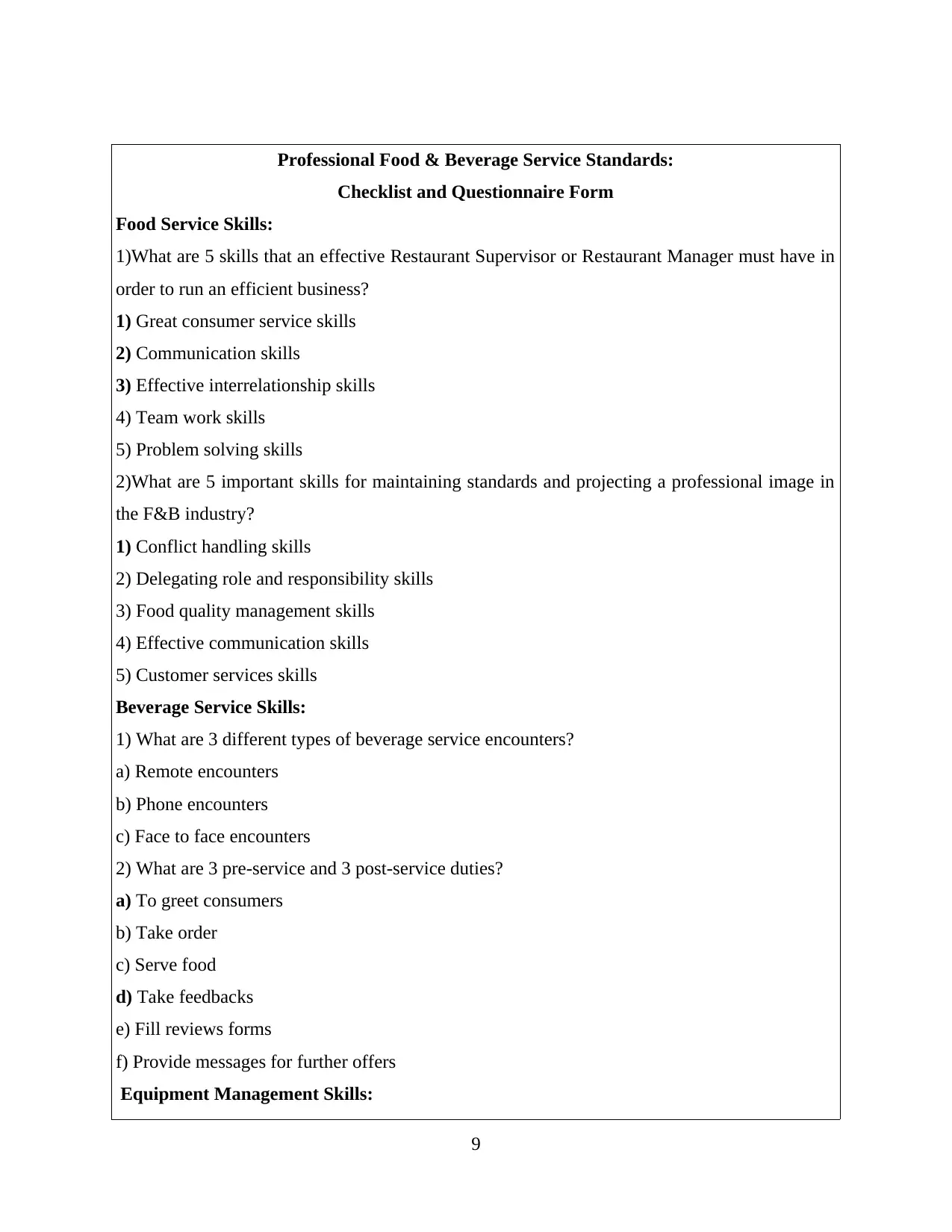
Professional Food & Beverage Service Standards:
Checklist and Questionnaire Form
Food Service Skills:
1)What are 5 skills that an effective Restaurant Supervisor or Restaurant Manager must have in
order to run an efficient business?
1) Great consumer service skills
2) Communication skills
3) Effective interrelationship skills
4) Team work skills
5) Problem solving skills
2)What are 5 important skills for maintaining standards and projecting a professional image in
the F&B industry?
1) Conflict handling skills
2) Delegating role and responsibility skills
3) Food quality management skills
4) Effective communication skills
5) Customer services skills
Beverage Service Skills:
1) What are 3 different types of beverage service encounters?
a) Remote encounters
b) Phone encounters
c) Face to face encounters
2) What are 3 pre-service and 3 post-service duties?
a) To greet consumers
b) Take order
c) Serve food
d) Take feedbacks
e) Fill reviews forms
f) Provide messages for further offers
Equipment Management Skills:
9
Checklist and Questionnaire Form
Food Service Skills:
1)What are 5 skills that an effective Restaurant Supervisor or Restaurant Manager must have in
order to run an efficient business?
1) Great consumer service skills
2) Communication skills
3) Effective interrelationship skills
4) Team work skills
5) Problem solving skills
2)What are 5 important skills for maintaining standards and projecting a professional image in
the F&B industry?
1) Conflict handling skills
2) Delegating role and responsibility skills
3) Food quality management skills
4) Effective communication skills
5) Customer services skills
Beverage Service Skills:
1) What are 3 different types of beverage service encounters?
a) Remote encounters
b) Phone encounters
c) Face to face encounters
2) What are 3 pre-service and 3 post-service duties?
a) To greet consumers
b) Take order
c) Serve food
d) Take feedbacks
e) Fill reviews forms
f) Provide messages for further offers
Equipment Management Skills:
9
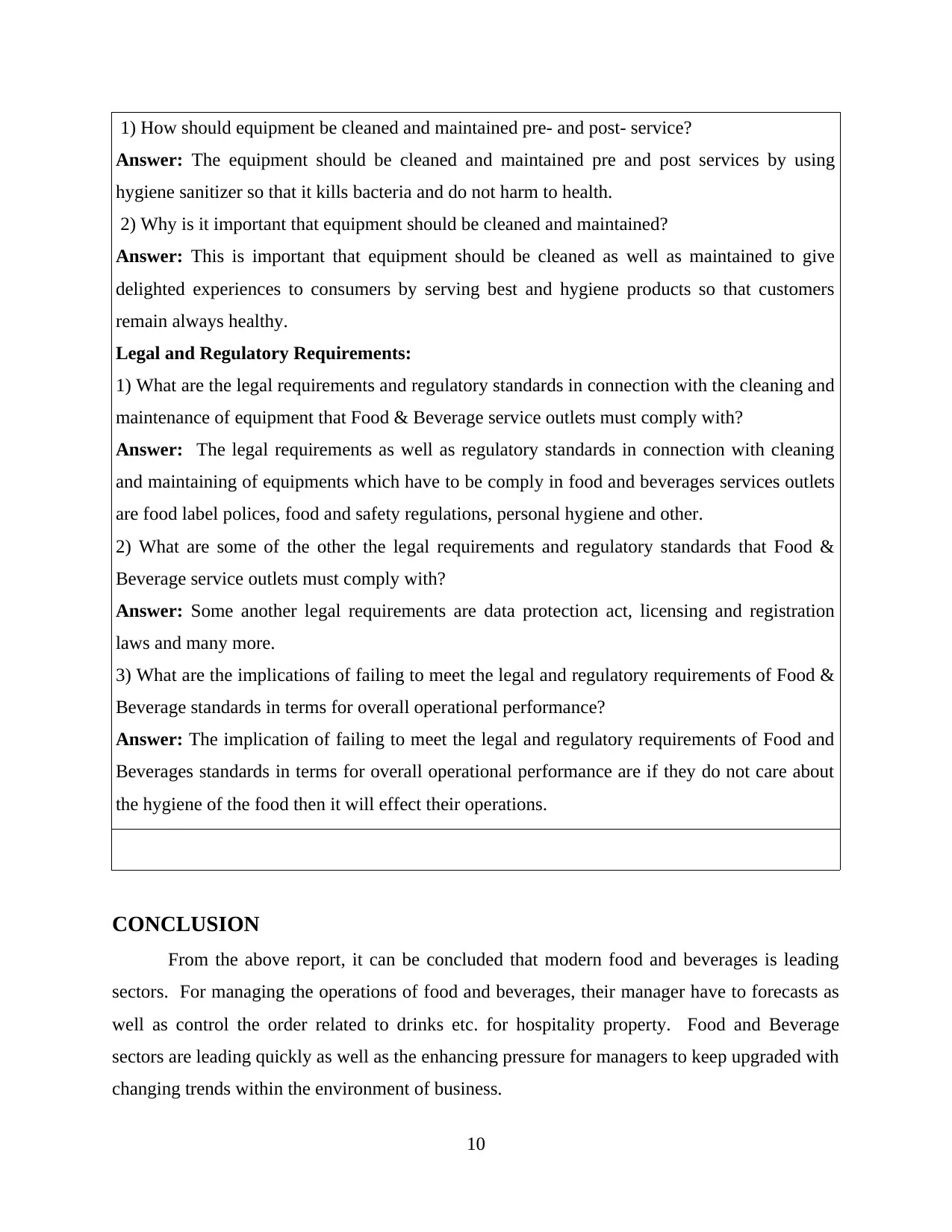
1) How should equipment be cleaned and maintained pre- and post- service?
Answer: The equipment should be cleaned and maintained pre and post services by using
hygiene sanitizer so that it kills bacteria and do not harm to health.
2) Why is it important that equipment should be cleaned and maintained?
Answer: This is important that equipment should be cleaned as well as maintained to give
delighted experiences to consumers by serving best and hygiene products so that customers
remain always healthy.
Legal and Regulatory Requirements:
1) What are the legal requirements and regulatory standards in connection with the cleaning and
maintenance of equipment that Food & Beverage service outlets must comply with?
Answer: The legal requirements as well as regulatory standards in connection with cleaning
and maintaining of equipments which have to be comply in food and beverages services outlets
are food label polices, food and safety regulations, personal hygiene and other.
2) What are some of the other the legal requirements and regulatory standards that Food &
Beverage service outlets must comply with?
Answer: Some another legal requirements are data protection act, licensing and registration
laws and many more.
3) What are the implications of failing to meet the legal and regulatory requirements of Food &
Beverage standards in terms for overall operational performance?
Answer: The implication of failing to meet the legal and regulatory requirements of Food and
Beverages standards in terms for overall operational performance are if they do not care about
the hygiene of the food then it will effect their operations.
CONCLUSION
From the above report, it can be concluded that modern food and beverages is leading
sectors. For managing the operations of food and beverages, their manager have to forecasts as
well as control the order related to drinks etc. for hospitality property. Food and Beverage
sectors are leading quickly as well as the enhancing pressure for managers to keep upgraded with
changing trends within the environment of business.
10
Answer: The equipment should be cleaned and maintained pre and post services by using
hygiene sanitizer so that it kills bacteria and do not harm to health.
2) Why is it important that equipment should be cleaned and maintained?
Answer: This is important that equipment should be cleaned as well as maintained to give
delighted experiences to consumers by serving best and hygiene products so that customers
remain always healthy.
Legal and Regulatory Requirements:
1) What are the legal requirements and regulatory standards in connection with the cleaning and
maintenance of equipment that Food & Beverage service outlets must comply with?
Answer: The legal requirements as well as regulatory standards in connection with cleaning
and maintaining of equipments which have to be comply in food and beverages services outlets
are food label polices, food and safety regulations, personal hygiene and other.
2) What are some of the other the legal requirements and regulatory standards that Food &
Beverage service outlets must comply with?
Answer: Some another legal requirements are data protection act, licensing and registration
laws and many more.
3) What are the implications of failing to meet the legal and regulatory requirements of Food &
Beverage standards in terms for overall operational performance?
Answer: The implication of failing to meet the legal and regulatory requirements of Food and
Beverages standards in terms for overall operational performance are if they do not care about
the hygiene of the food then it will effect their operations.
CONCLUSION
From the above report, it can be concluded that modern food and beverages is leading
sectors. For managing the operations of food and beverages, their manager have to forecasts as
well as control the order related to drinks etc. for hospitality property. Food and Beverage
sectors are leading quickly as well as the enhancing pressure for managers to keep upgraded with
changing trends within the environment of business.
10
⊘ This is a preview!⊘
Do you want full access?
Subscribe today to unlock all pages.

Trusted by 1+ million students worldwide
1 out of 13
Related Documents
Your All-in-One AI-Powered Toolkit for Academic Success.
+13062052269
info@desklib.com
Available 24*7 on WhatsApp / Email
![[object Object]](/_next/static/media/star-bottom.7253800d.svg)
Unlock your academic potential
Copyright © 2020–2025 A2Z Services. All Rights Reserved. Developed and managed by ZUCOL.





